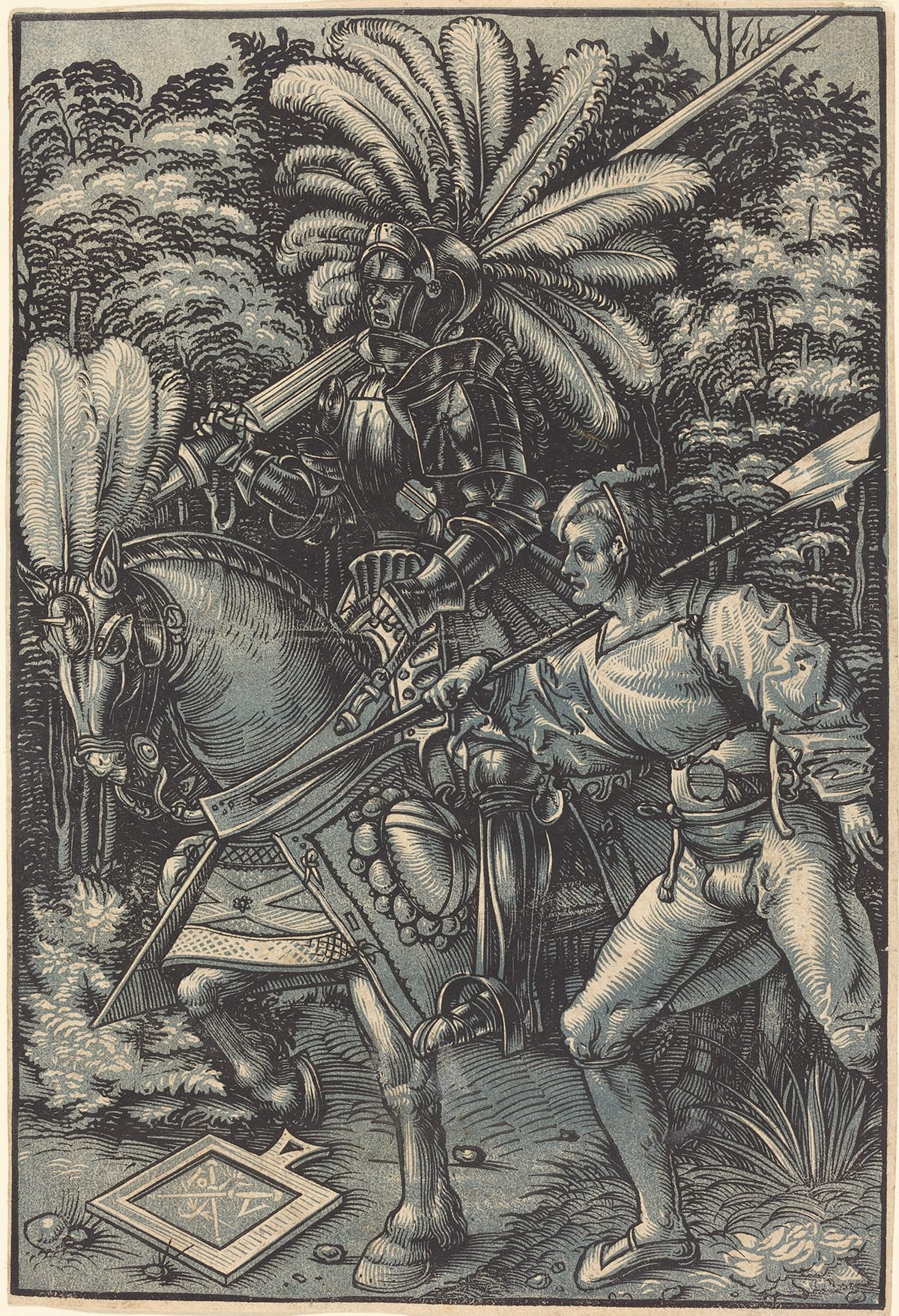The Fighter: Blood and Steel

The Fighter is one of my favorite archetypes in narrative games. If well-designed, it's rarely just about being better at combat, but about how "being good at fighting" affects how others view you and how you view yourself. Is the fighter seen as a cold mercenary, a noble protector, or a bloodthirsty murderer? What does it mean to have that power, not from magic or spirits, but through blood, sweat, and tears? How did gaining that power change you, and what does it mean to wield it?
In a way, this is just a distillation of how many D&D parties relate to power in many traditional campaigns. The group gets stronger as they level up, and the world and its NPCs start recognizing their strength and reacting to it. The same enemies that confidently challenged the PCs at level 2 now rely on traps and ambushes to stand a chance at level 5. They need to grapple with the power the party possesses, finding ways to get stronger themselves, or teaming up with a stronger entity who can help them.
Many of fiction's most formidable warriors masterfully navigate these power dynamics to defeat their enemies without ever drawing their blade. They might notice blind spots, analyze fighting styles, or scare someone off. Because of their training and experience, they can probably also maintain their equipment, treat wounds in the field, and perform extended physical labour.
Overall, being a Fighter is about far more than just swinging a sword. That energy was already present in Dungeon World 1, with moves like Seeing Red and Evil Eye, and we wanted to make it even more apparent in Dungeon World 2.
Origins and Backstory
It's a thankless job, living day to day by the strength of your arm and the skin of your teeth. You bear your scars with pride, sharpen your sword with precision, and don your armor with practiced ease. Let every danger test itself against you. In the end, you’ll be the last one standing.
Ancestry: What do you look like? How does your ancestry affect your biology, behavior, and communication? How does your ancestry affect how you fight?
Culture: How respected are warriors in your culture? What unique weapons, styles, or tactics does your culture practice?
Background: How was your life before adventuring? What caused you to take up the sword? Was it demanded of you, or did you reach for it despite everything?
Backstory: At character creation, mark one Facet of your backstory and answer its associated questions:
- A former comrade now stands as your enemy. Who were they to you? What led to your falling out? Resolve this by defeating or reconciling with them.
- An act or a life of violence broke something in you. Was it something done by you or done to you? How does your trauma manifest? How do you cope? Resolve this by finding a path to start healing.
- You once championed a cause or ideal alongside several like-minded associates. What happened to change that? Who still remains? Resolve this by cleaning up the fallout or finishing the fight.
From these suggested Facets, it's clear that we envision the Fighter as someone with a rough past that pushed them to become an adventurer. Maybe they used to be a guard, footsoldier, or gladiator. Whatever it was, they can't go back to it.
Evolving the Game
We've been updating DW2 a lot over the past few weeks. We'll make a big post around when the Alpha releases (SoonTM) summarizing what has changed. Like we've said many times before, this is still the experimental phase of the game.
But since it matters so much to this Class, here is what the old "Fight" Move currently looks like at the moment.
Engage a Threat
When you exchange blows with a threat, up close or at a distance, roll+Forceful. *On a 7-9, choose one:
- You hurt them; they mark a condition and then escalate
- You exhaust, distract, or intimidate them; add 1 Kinship to the pool
- You take something from them (if it makes sense in the fiction)
*On a 10+, choose two from including these options as well:
- You avoid their retaliation
- If you've already chosen to hurt them, you inflict terrible harm; they mark another condition, but don't escalate again
And here is why this move matters much to the Fighter.
Feature: Combat Maneuvers
You've learned techniques to better defeat your enemies and protect yourself and your allies. Mark two of them as Mastered now:
☐ Bait & Switch — When someone close is about to receive an attack, you can exchange places and receive the attack yourself.
☐ Block & Duck — You have 1 Block, which can be spent like a Forceful Resistance but refreshes at the start of each scene.
☐ Duelist — When you Fight someone one-on-one you choose an extra option from the list, even on a miss.
☐ Flourish — When you Fight and you exhaust, distract, or intimidate them, add 2 Kinship to the pool (instead of 1).
☐ Hamstring — When you Fight, you can stop them from escaping until they defeat you (or the scene ends).
☐ Interrogate — When you Fight, you can ask your opponent’s player one question as if you Read them successfully.
☐ Safeguard — When you Push Yourself to Fight, on a 7+ you always avoid their retaliation (in addition to any other choices you make).
☐ Terrify — When you Fight, you can also become the center of attention until something big changes.
As you can see, the extra choices here are available on either a 7-9 or a 10+. On a 6- you don't make choices (other than when using Duelist), so the extra options don't help then.
Starting Moves
Second Wind
You can Push Yourself one extra time per session.
Sterner than Steel
Once per session, when you mark a condition, refresh 1 spent Resistance of your choice.
Take Counsel
When you go looking for someone you know from a past battle, friend or foe, choose one from the following list—or two if you owe them or put them at risk (your call):
- They’re willing to assist you with a current conflict
- They offer guidance, advice, or safety for some time
- They reveal a significant secret or opportunity
That last Move above is an interesting one, inherently giving the Fighter a social element that doesn't rely on Compelling, and letting them tie their battle experience into the current narrative. The move doesn't specify that past battles need to be from before character creation. Maybe an enemy the group imprisoned in their first adventure can help with a much worse threat now.
Starting Equipment
Gear
Choose one from each line (or write your own with the GM’s permission):
- inscribed sword, intimidating greataxe, twin blades
- polished plate, studded leather, weathered chainmail
- backup weapon, iconic helmet, rare metal shield
Supplies
You start with Adventuring Supplies and Crafting Supplies.
You also start with either ☐ Cooking Supplies or ☐ Medical Supplies.
Adventuring Supplies are a new supply type, and one that every Class starts with. It has the more generic adventuring gear that everyone is assumed to have, like torches, rope, a bedroll, and similar.
Advancements
When you Level Up, choose one of the following:
☐ ☐ Gain an Advanced Move from your Class
☐ Multiclass — Gain an Advanced Move from another Class
☐ ☐ +1 to any Stat (max. +2)
☐ +1 to two different Resistances
☐ Change to a new Class, then gain another Advancement
☐ Acquire a Magic Armor, Tool or Weapon
☐ Unlock another type of Supplies
☐ Master a new Combat Maneuver
☐ Mark another Facet of your backstory
After you Level Up five times, you can also choose from the following list:
☐ ☐ ☐ Gain an Advanced Move from your Class
☐ ☐ Multiclass — Gain an Advanced Move from another Class
☐ +1 to any Stat (max. +2)
☐ +1 to any Stat (max. +3)
☐ +1 to two different Resistances
☐ Acquire an Artifact Armor, Tool or Weapon
☐ ☐ Master a new Combat Maneuver
☐ Not to Be Trifled With. When you Engage a Threat, you always hurt them in addition to your normal choices, even on a 6-.
The Fighter pinnacle move above is very simple, but extremely powerful. Like all similar advancements, it's meant to be a bit of a game-changer.
Advanced Moves
Anti-Magic Training
When you Resist magic the first time each scene, it costs no Resistance.
Imposing Presence
When you Sway through intimidation, you may roll +Forceful (instead of +Compelling). On a 12+, add 1 Kinship to the pool.
Eye for Weakness
Once per session, choose an enemy and the GM will tell you all of their Resistances. Choose one of those Resistances; it doesn’t work against you.
NPC Resistances aren't numbers or armor, but rather what an NPC is fictionally strong against or prepared for. Facing an NPC's Resistance head-on is much harder, or even impossible, compared to finding a way around it.
For some examples, a dragon might resist "ordinary blows to its hide" and "listening to anyone not properly deferential", while a master thief might resist "being seen in the shadows" and "opposing subterfuge".
Versatile Fighting
You can Fight +Slippery (instead of +Forceful).
Veteran's Intuition
When you get a bad feeling about an upcoming situation (your call), ask the GM how to avoid or prepare for it and they will give you one piece of advice; add 1 Kinship to the pool.
Wreck
When you want to destroy something—be it a building, magical artifact, or obstacle—tell the GM your intentions. It is always possible, but the GM will give you 1 to 4 of the following requirements (separated by “and”s or “or”s).
- It’s going to take hours/days/weeks.
- First, you must ___________.
- You’ll need help from ___________.
- You’ll need to use ___________.
- It will be easy/difficult to repair.
- You and your allies will risk ___________.
- You’ll have to use up/wear out ___________.
You can use this to do things like start a cave-in, break down a wall, blow up a building, or shatter an unbreakable sword, just to name a few.
That's everything for the Fighter! I hope it delivers on our vision for it spelled out in the first part of this post.
Stay tuned for this Tuesday, where we show off the Rogue.
Spencer
